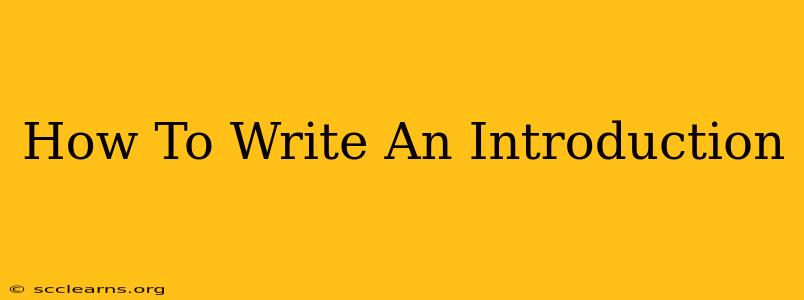Writing a compelling introduction is crucial for any piece of writing, whether it's a blog post, essay, novel, or even a presentation. A strong introduction grabs your reader's attention, sets the tone, and clearly lays out the purpose of your writing. This guide will walk you through the essential elements of crafting an effective introduction that will leave your audience wanting more.
Understanding the Purpose of Your Introduction
Before diving into the specifics, it's important to understand what your introduction needs to achieve. Its primary goals are:
- Grab the reader's attention: Hook them from the start and make them want to read on.
- Establish context: Briefly provide background information relevant to your topic.
- State your thesis or main point: Clearly and concisely state the central argument or purpose of your writing.
- Outline the structure (optional): For longer pieces, you might briefly preview the main points you'll be covering.
Techniques for Writing a Hook
The opening sentence (or two) of your introduction is critical. Here are several effective techniques to capture your reader's attention:
1. Start with a compelling question:
This immediately engages the reader and makes them think. For example, "Have you ever wondered why...?" or "What if...?"
2. Begin with a surprising or intriguing statistic:
A shocking or unexpected statistic can instantly pique interest. Make sure to cite your source.
3. Open with a relevant anecdote or story:
A short, relatable story can create an emotional connection with the reader and make your topic more engaging.
4. Use a strong quote:
A powerful quote from a relevant authority can lend credibility and add intrigue to your introduction.
5. Start with a bold statement:
A confident and assertive statement can grab attention, but make sure it's accurate and well-supported in the body of your writing.
Crafting the Body of Your Introduction
After your hook, you need to smoothly transition into the context and thesis statement. Here's how:
Providing Context
Briefly provide necessary background information. Don't overload the reader with details, but offer enough context to understand the topic.
Stating Your Thesis
This is arguably the most crucial part of your introduction. Clearly and concisely state the main point or argument you'll be making. This acts as a roadmap for your reader, guiding them through your writing.
Examples of Effective Introductions
Let's look at some examples showcasing different approaches:
Example 1 (Question Hook): "Have you ever felt overwhelmed by the sheer volume of information available online? This post will explore effective strategies for improving your focus and maximizing your productivity in the digital age."
Example 2 (Statistic Hook): "Over 70% of internet users report feeling stressed by social media. This article examines the impact of social media on mental well-being and offers practical tips to manage its effects."
Conclusion: Practice Makes Perfect
Writing a captivating introduction takes practice. Experiment with different hooks and styles to find what works best for your writing style and your audience. The more you write, the better you'll become at crafting introductions that successfully engage your readers and set the stage for a compelling piece of writing. Remember to always revise and refine your introduction to ensure clarity, impact, and a strong connection with your audience.

